2004
2004 CTAUN Conference
Friday, January 30, 2004
Poverty-Partnerships-Peace: The Role of Educators in the 21st Century
Summary of Conference Proceedings
Welcome—Anne-Marie Carlson
Conference Chair
 Mrs. Carlson, Conference Chair and Chair of the Committee on Teaching About the United Nations (CTAUN), welcomed the participants. She announced that this is the sixth in an annual series planned and convened by CTAUN in association with the United Nations Department of Public Information (UN/DPI).
Mrs. Carlson, Conference Chair and Chair of the Committee on Teaching About the United Nations (CTAUN), welcomed the participants. She announced that this is the sixth in an annual series planned and convened by CTAUN in association with the United Nations Department of Public Information (UN/DPI).
She also announced that the presenters for the day came from various groups: the United Nations; UN-related groups such as UNICEF, the World Bank, and the World Federation of United Nations Associations; and other groups related to the conference topic such as Right to Play, Trickle Up, International Movement ATD Fourth World, and Heifer International. The speakers were nationals of eight different countries.
Mrs. Carlson reported that 427 people registered for the conference. They came from five countries—the United States, Canada, Mexico, Norway, and Denmark. Thirty states and the District of Columbia were represented from the U.S.A. and three provinces-Ontario, Quebec, and Nova Scotia—represented Canada.
Opening Address
Catherine Bertini
UN Under-Secretary-General for Management
The opening speaker for the day, Catherine Bertini, is the senior American official in the United Nations Secretariat.
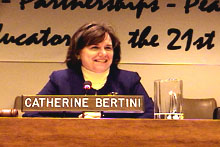 Ms. Bertini said that she was delighted to be in dialogue with teachers because she believes that “we, the people,” acting together, can make a difference. She went on to say that she was raised in Cortland, New York, where she had learned the community values of middle America, and she was now proud to be the senior American in the UN Secretariat.
Ms. Bertini said that she was delighted to be in dialogue with teachers because she believes that “we, the people,” acting together, can make a difference. She went on to say that she was raised in Cortland, New York, where she had learned the community values of middle America, and she was now proud to be the senior American in the UN Secretariat.
When Ms. Bertini took over as Executive Director of the World Food Program (WFP) in Rome, she was happy to find that the people on her international staff all had the same aspirations and commitment to work for better opportunities and a better life for deprived people everywhere. Her work has taken her to trouble spots all over the world. When she first went to Mozambique she had to have a military escort to take her around the country. She has worked in post-civil-war UN programs in Kosovo and East Timor, and now she hopes that peace is also coming to Angola, Sudan, and Somalia. In spite of the terrible shock of the deaths of so many UN staff members in Iraq on August 19, 2003, she believes that the UN would continue to work for a new governmental process in Iraq.
Ms. Bertini stressed that the UN is the international leader in the humanitarian field, bringing clean water, disaster relief, and help to refugees. All of this adds up to a huge agenda, which goes on alongside the work of the UN for peace and security. And it is all voluntarily funded, with the donors requiring strict accounting for all the projects undertaken. The UN also undertakes a wide range of important regulatory work, which gets no publicity, in food safety, in rules for air traffic, in intellectual property, and in disease control. The UN works to ensure that the world stays safe.
The World Food Program has worked in crisis situations in North Korea and the horn of Africa to bring food and water to the people. In Afghanistan, she worked to make it possible for widows, who were not allowed under the Taliban to leave home, to start their own bakeries, and she had ensured that small private schools for girls were able to keep going. Girls need help with nutrition and health care. Far too many women are working night and day to support their families and to bring up their children. Ms. Bertini said that she is passionate about better education for women and girls.
Ms. Bertini gave advice to young people who would like a career at the UN. She suggested that they begin in local community service, get an M.A., learn another language, and try first to become an intern in the UN system.
She concluded by saying that teachers had made all the difference in her life. When she received the World Food Prize in 2003, nothing made her happier than to see her fourth-grade teacher sitting in the front row at the ceremony.
Morning Panel
Poverty
Andres Guerrero
Education Programme Officer, UNICEF, Moderator
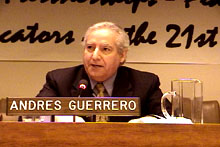 Mr. Guerrero was both the moderator and a speaker for this panel. He said that he spoke as a teacher among teachers about his experiences dealing with the “World Fit For Us” statement developed by adolescent children at the UN. The presentation of this statement by two adolescents marked the first time that young people had spoken directly to the General Assembly.
Mr. Guerrero was both the moderator and a speaker for this panel. He said that he spoke as a teacher among teachers about his experiences dealing with the “World Fit For Us” statement developed by adolescent children at the UN. The presentation of this statement by two adolescents marked the first time that young people had spoken directly to the General Assembly.
Mr. Guerrero stressed that the denial of human rights is not a marginal issue and that severe deprivation of human rights leads to violence. The Millennium Development Goals (MDGs) represent a shared vision by the international community that by 2015 the number of those in poverty be cut in half.
The barriers to acquiring a quality education and achieving one’s potential are many and varied, only beginning with: being orphaned, losing one’s teachers to AIDS, hunger, despair, the disruption caused by conflict, and the effects of social injustice. The management of education needs to be changed to ensure the active participation of all.
Mr. Eduardo Doryan
Special Representative of the World Bank to the UN
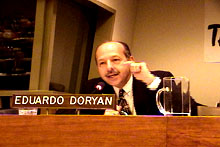 Mr. Doryan spoke from the viewpoint of the leaflet “Making Services Work for Poor People: A Pathway to the Millennium Development Goals,” which he distributed to the attendees. Pointing to the statistics in this leaflet, he commented that the number of people living on less than $1 a day has declined from 1.3 billion to 1.2 billion over the past thirty years. Thus, for the first time one million people have been lifted out of poverty.
Mr. Doryan spoke from the viewpoint of the leaflet “Making Services Work for Poor People: A Pathway to the Millennium Development Goals,” which he distributed to the attendees. Pointing to the statistics in this leaflet, he commented that the number of people living on less than $1 a day has declined from 1.3 billion to 1.2 billion over the past thirty years. Thus, for the first time one million people have been lifted out of poverty.
The global economic imbalance, however, is still the main source of difficulty in the achievement of peace and security. The percent of the global population living on less than $1 a day is much higher in the less well developed parts of the world. Figures on the prevalence of undernourishment show the same trend. The figures on adults and children newly affected with HIV as of 2002 are much higher in Sub-Saharan Africa than anywhere else in the world.
Poor conditions affect generations and genders unevenly. For example, lack of adequate infrastructure and sanitation, as well as a lack of female teachers, keep girls out of school disproportionately. Mr. Doryan pointed out that to be truly effective there must be a triangular framework of accountability relationships between policy makers, providers, and the poor people themselves to ensure that the delivery of services gets all the way to the schools. Education is about the empowerment and self-esteem necessary to build a sustainable peace for all.
Sister Florence Deacon
Chair of the NGO Sub-Committee for the Eradication of Poverty and Director, New York International Office, Franciscans International
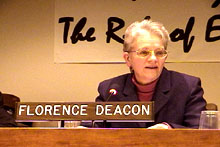 Sister Florence opened her talk by describing how in 1995 the UN General Assembly planned the first UN Decade for the Eradication of Poverty (1997-2006). The members knew then that it would take more than one decade to reach this goal. Despite the growth in the world’s economy in the 1990s, the rising economic tide did not lift all boats. Today there are more countries in poverty, more children dying prematurely, and a larger gender gap in health and well-being than there were ten years ago.
Sister Florence opened her talk by describing how in 1995 the UN General Assembly planned the first UN Decade for the Eradication of Poverty (1997-2006). The members knew then that it would take more than one decade to reach this goal. Despite the growth in the world’s economy in the 1990s, the rising economic tide did not lift all boats. Today there are more countries in poverty, more children dying prematurely, and a larger gender gap in health and well-being than there were ten years ago.
Nevertheless, there are positive grassroots initiatives changing the lives of the poor. The Sub-Committee for the Eradication of Poverty, which is part of the NGO Committee for Social Development, has published a survey of these initiatives. This report, “Best Practices in Poverty Eradication: Case Studies from the Field,” highlights efforts being made by people in direct service, as well as their advice to policy makers. They stress that poverty is multifaceted, complex, and embedded. Micro-credit alone is not enough to overcome it. It is important to address all of the Millennium Development Goals simultaneously, including education, sanitation, women’s rights, AIDS, nutrition, etc.
Sister Florence stressed that no people are too poor to create their own projects. In a project in Mozambique, the poor participate in every step of planning and evaluating community projects. She referred to several excellent projects in Bolivia. One of these looked at the challenge of bringing educated people to an isolated mountain area where indigenous children lacked schooling. The answer was to found a university for campesinos, training local youth in agriculture and veterinary science in ways that benefit the whole community at every step of the process. As one respondent said, the untapped excellence of the poor is wasted.
She also quoted respondents in citing the importance of such global issues as debt relief for the most indebted countries and asking the various international financial institutions to ensure internal consistency in their dealings with poor countries. It is important that governments be held to their commitments in financing projects in developing nations. We cannot let the nations’ budgets be derailed by the search for security against terrorism when we know that a worldwide coalition against poverty is needed to create lasting security and peace.
First Afternoon Session
UN Partnerships
Pera Wells
Deputy Secretary General, World Federation of United Nations Associations (WFUNA), Moderator
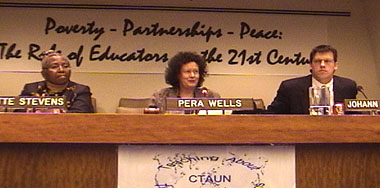
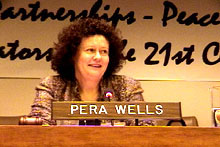 Ms. Wells opened the panel with a brief overview of the goals of education during different periods in modern times. Up to the 1960s, the primary goal of education was to qualify students to enter a profession. In the 60s, 70s, 80s and 90s there was more emphasis on education to solve societal problems, although during the Clinton administration academics were viewed as perhaps the most important goal of education. In the 21st century a primary purpose of education is to equip students to be responsible for the administration of justice, in line with the UN Millennium Development Goals.
Ms. Wells opened the panel with a brief overview of the goals of education during different periods in modern times. Up to the 1960s, the primary goal of education was to qualify students to enter a profession. In the 60s, 70s, 80s and 90s there was more emphasis on education to solve societal problems, although during the Clinton administration academics were viewed as perhaps the most important goal of education. In the 21st century a primary purpose of education is to equip students to be responsible for the administration of justice, in line with the UN Millennium Development Goals.
Yvette Stevens, Director
UN Office of the Special Advisor on Africa
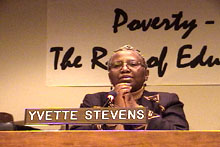 Ms. Stevens said that she was born in Sierra Leone “a few years ago.” She has taught engineering. She has been for the past twenty years with the UN as Special Officer and Advisor on Africa, with emphasis on the impact of peace and security on development. As a child she fetched and carried water, washed clothes, and went barefoot to school. Stevens thanks her parents and teachers for giving her an education when schooling, especially for females, was unusual.
Ms. Stevens said that she was born in Sierra Leone “a few years ago.” She has taught engineering. She has been for the past twenty years with the UN as Special Officer and Advisor on Africa, with emphasis on the impact of peace and security on development. As a child she fetched and carried water, washed clothes, and went barefoot to school. Stevens thanks her parents and teachers for giving her an education when schooling, especially for females, was unusual.
Ms. Stevens thanked CTAUN for looking at sub-Saharan Africa-the poorest region in the world. She stated that she believes the world as a whole cannot move forward when one region remains so disadvantaged. Sub-Saharan Africa is the only region with no chance of reaching the UN Millennium Goal for education on schedule. A review of the progress during the 1990s showed little or no improvement due largely to conflicts, lack of democratic political structures, and poverty.
The 2001 African leaders’ initiative “New Partnerships for African Development” (NEPAD) must take ownership and responsibility for this region, but this will not be possible without genuine partnerships. The enormous problems of this region cannot be solved simply through “relief,” although this may be important right now. They can only be met through empowerment and partnerships.
Teachers will play a big role, both in and out of Africa, directly and through partnerships. Education must be geared to meet today’s needs, and outmoded educational models radically revised. Teachers need to be educated themselves and to inform and educate their students regarding societal problems and the roles to be played in solving or resolving these.
Ms. Stevens sees a tremendous potential for linking African schools and US schools and individual classrooms. The impact of such contacts in huge and is becoming technically easier, at least in some areas. Where computer communication is not possible, there is always mail-slow but effective. Ms. Stevens would be most interested in working on school linkages with CTAUN and individual schools and teachers.
Mr. Johann Olav Koss
President and CEO, Right to Play;
UNICEF Goodwill Ambassador;
Four time Olympic Gold Medalist in Speed Skating.
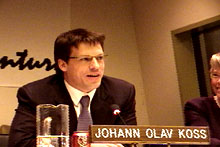 Mr. Koss’s Olympic medals have made him a remarkable and effective ambassador for UNICEF. He believes that incorporating “Right to Play” into educational curricula worldwide is essential and effective. He stated that play is a natural tool that can be used to educate children, many of whom have limited access to play because of work, poor health, political issues, etc. Sports for children, especially in orphanages, are valuable and inexpensive. By teaching adults to become coaches and instructors, a new information and delivery system is created. Coaches have a different, sometimes closer, relationship with children and can be influential in teaching healthy lifestyles, for example in combating malaria and protecting against AIDS. Teaching about protecting against HIV/AIDS proved to be more difficult but effective, as demonstrated in a Nairobi soccer club where less than 2 percent of the children involved were infected as compared to 16-20 percent in a non-sports-involved group. Sports programs in refugee camps, where most youngsters and teens are inactive, have increased school attendance and helped to prevent the recruitment of children as soldiers.
Mr. Koss’s Olympic medals have made him a remarkable and effective ambassador for UNICEF. He believes that incorporating “Right to Play” into educational curricula worldwide is essential and effective. He stated that play is a natural tool that can be used to educate children, many of whom have limited access to play because of work, poor health, political issues, etc. Sports for children, especially in orphanages, are valuable and inexpensive. By teaching adults to become coaches and instructors, a new information and delivery system is created. Coaches have a different, sometimes closer, relationship with children and can be influential in teaching healthy lifestyles, for example in combating malaria and protecting against AIDS. Teaching about protecting against HIV/AIDS proved to be more difficult but effective, as demonstrated in a Nairobi soccer club where less than 2 percent of the children involved were infected as compared to 16-20 percent in a non-sports-involved group. Sports programs in refugee camps, where most youngsters and teens are inactive, have increased school attendance and helped to prevent the recruitment of children as soldiers.
Mr. Koss regards sports as a unique way to build democracy and to connect schools. As physical education programs in the United States and the west decline, participation in “links” to schools in other countries increase sports participation at home. Linked programs create two advantages: improvements for our own children and improvements for children in disadvantaged parts of the world. In Canada, several schools have launched fundraising activities to support school sports programs in another country.
A particular goal for UNICEF this year is to improve access for females in sports and athletic activities. In one instance this has meant creating a private space for girls to play where they cannot be observed by men and boys. The success of this program has been acknowledged even by those who initially opposed it.
Children are our most valuable assets and they will find a way to play together. In Africa, one lad’s arrival was cheered. He had a shirt with long sleeves that could be knotted into a ball. Sometimes all it takes is a soccer ball-even a homemade one-to make a difference.
Second Afternoon Session
Partnerships Panel
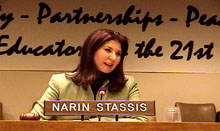
Ms. Narin Stassis
First Vice-Chair of CTAUN, and ESL teacher and coordinator for the West Paterson School District in New Jersey, Moderator
Dr. Donna Katzin
Founder and CEO of Shared Interest
Dr. Katzin said that Shared Interest had been founded in 1994 to make sure that South Africans obtained economic freedom as well as political freedom. Shared Interest encourages South African banks to give loans to hundreds of people who formerly would have been outside the banking system.
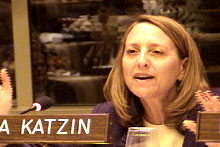 Under Apartheid the wealth of the country went to 20 percent of the people at the expense of the other 80 percent. Even now, at the Tenth Anniversary of the end of Apartheid, 25 percent of the population are still officially waiting for homes and there is 40 percent unemployment. Shared Interest provides collateral to South African banks, and now, due to this project 62,000 families have been housed and the lives of 350,000 people have been affected.
Under Apartheid the wealth of the country went to 20 percent of the people at the expense of the other 80 percent. Even now, at the Tenth Anniversary of the end of Apartheid, 25 percent of the population are still officially waiting for homes and there is 40 percent unemployment. Shared Interest provides collateral to South African banks, and now, due to this project 62,000 families have been housed and the lives of 350,000 people have been affected.
Dr. Katzin explained the principles of partnership that have guided Shared Interest’s work:
Shared Interest is operating in rural as well as urban areas. One project is now employing 7500 rural workers. This started when one woman was helped to take up a beekeeping business. Not only was this enterprise successful, it has also created beneficial partnerships. Mining companies have let the beekeepers enter their fenced-off land. White farmers are cooperating and using the bees to pollinate their crops. The University of Pretoria is doing research on new medicines that utilize bee by-products to tackle drug-resistant tuberculosis. Finally, rural communities are, for the first time, being gradually linked to the mainstream economy.
Mr. Jonah Gensler
Director of Trickle Up
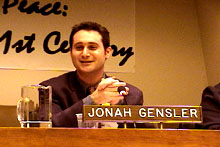 Trickle Up is a program designed to help the lowest-income people globally by providing conditional seed capital and business training for the launching of microenterprises in the effort to counteract the “trickle down” economic effects of the 1970s and 1980s. Each person or group completes a business plan, pledging 250 hours of work per person in a three-month period and savings or reinvestment of at least 20 percent of the profit. These people have no credit, so the Trickle Up seed capital is the first formal financing they have ever received. Usually Trickle Up provides a small grant as the first step up a ladder of programs that include education and targeted training. The organization educates and empowers the world’s most impoverished people to be self-sufficient, realize their potential, and strengthen their communities.
Trickle Up is a program designed to help the lowest-income people globally by providing conditional seed capital and business training for the launching of microenterprises in the effort to counteract the “trickle down” economic effects of the 1970s and 1980s. Each person or group completes a business plan, pledging 250 hours of work per person in a three-month period and savings or reinvestment of at least 20 percent of the profit. These people have no credit, so the Trickle Up seed capital is the first formal financing they have ever received. Usually Trickle Up provides a small grant as the first step up a ladder of programs that include education and targeted training. The organization educates and empowers the world’s most impoverished people to be self-sufficient, realize their potential, and strengthen their communities.
Although this program operates globally, Mr. Gensler announced that his focus in this talk would be from the perspective of the thirteen states that participate in the program in the United States. New York City, for example, has had great success in establishing childcare centers in Bedford-Stuyvesant. The model is to renovate someone’s home, usually a woman’s, to accommodate up to fourteen children. The person has a space fixed up to meet safety, staffing, and licensing standards and learns how to manage cash flow and marketing skills, creating new minimum-wage jobs in the process.
Mr. Gensler emphasized the necessary connection between health care, education, and the economy. Newer programs further build viable businesses to provide schools. The aim of Trickle Up is to assist people to work out of poverty by stressing the creation of better families and safer communities worth living in.
Ms. Lenore Cola
International Movement ATD Fourth World Representative accompanied by Ms. Raneisha Williams, student and member of Tapori.
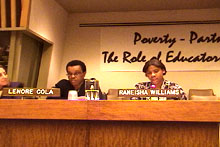 The International Movement ATD Fourth World is a partnership of families living in persistent poverty and other citizens worldwide, working for human rights and the eradication of extreme poverty. Tapori is the children’s branch of this movement.
The International Movement ATD Fourth World is a partnership of families living in persistent poverty and other citizens worldwide, working for human rights and the eradication of extreme poverty. Tapori is the children’s branch of this movement.
Ms. Cola and Ms. Williams took part in a dialogue about the work of Tapori, which is a worldwide network of children whose motto is: “We want all children to have the same chances.” Through its newsletter, Tapori reaches thousands of children ages 6 to 13 in schools and communities throughout the United States and in 60 countries. The newsletter is published six times a year in English, French and Spanish and recounts the true stories, efforts and projects of children and their families-both poor and non poor—and is the struggle against poverty and social exclusion around the world.
The Fourth World Volunteer Corps members help parents and young people living in very poor areas. They facilitate groups that meet regularly in schools, community and faith-based centers, and in homes. The groups use the Tapori newsletter, minibooks and campaigns as resources to help them devise their own local projects. Children not in poverty are helped to clarify their understanding of what poverty entails, and children in poverty come to see themselves, their projects, and their families’ struggles in a new and positive light. Tapori is a partnership of learning.
Ms. Sue Bertrand
Vice President for Global Services, Heifer International
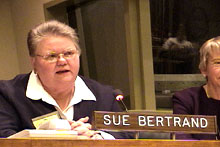 Ms. Bertrand began by describing the evolution of Heifer International from its origin as a United States Department of Agriculture program restocking farms in post-World War II Europe. At present, Heifer International is a global program through which 45 countries are provided with locally trained staff and 27 species of animals in order to bring about community development through livestock. The Heifer project recognizes that in many parts of the world education is a luxury. Its task, therefore, is to bring families out of poverty so that they have choices.
Ms. Bertrand began by describing the evolution of Heifer International from its origin as a United States Department of Agriculture program restocking farms in post-World War II Europe. At present, Heifer International is a global program through which 45 countries are provided with locally trained staff and 27 species of animals in order to bring about community development through livestock. The Heifer project recognizes that in many parts of the world education is a luxury. Its task, therefore, is to bring families out of poverty so that they have choices.
In the United States, racism is often at the root of hunger because people are reduced to a state of poverty in which they are not able to be productive. In 1996, therefore, Heifer started pilot projects in urban agriculture in areas where there is the greatest concentration of youth at risk. The aim is to engage the people who live in the community to be part of the solution. Partnerships consist of people receiving resources from Heifer for three to five years. The resulting projects may have an educational component. For example, projects such as green markets and poultry raising teach mathematical skills.
A hallmark of a contract with Heifer is the promise to “pass on the gift.” Thus, the recipient in turn becomes a donor. Ms. Bertrand related how she herself was a Heifer recipient. In time she had a large sheep farm, and now she works in the international division of Heifer. Other programs are “Read to Feed” and a peace project with Rotary International in Kosovo in which weapons are exchanged for livestock.
Closing Keynote Address
Kul C. Gautam
Assistant Secretary-General and Deputy Executive Director, United Nations Children’s Fund (UNICEF)
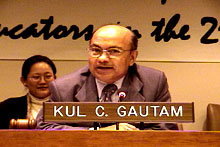 Mr. Gautam opened his talk by sharing memories of his own childhood in a remote village in Nepal where there was no school at that time and 95 percent of the villagers were illiterate. He was taught in the house of a village priest who gave lessons to a few of the village boys. Mr. Gautam saluted the teachers present, saying that from that humble beginning on to the grants and scholarships which supported his attendance at fine Ivy League colleges, he has always been inspired by his teachers.
Mr. Gautam opened his talk by sharing memories of his own childhood in a remote village in Nepal where there was no school at that time and 95 percent of the villagers were illiterate. He was taught in the house of a village priest who gave lessons to a few of the village boys. Mr. Gautam saluted the teachers present, saying that from that humble beginning on to the grants and scholarships which supported his attendance at fine Ivy League colleges, he has always been inspired by his teachers.
UNICEF believes that there is no more essential foundation for human development than the education of all children. Yet quality education, even at the elementary level, remains a distant dream for millions of children around the world. There are countries and communities where there are more children out of school than in school. Today there are 121 million children who never see the inside of a classroom. And the vast majority of these out of school children are girls, which is why UNICEF chose to focus on girls’ education as the theme of its State of the World’s Children Report this year.
Mr. Gautam went on to enumerate reasons for this focus on girls. Although UNICEF is dedicated to educating all children, girls face much greater obstacles and discrimination in getting educated than boys. Thus, girls from poor families face a double jeopardy-the deprivation caused by poverty and the disadvantage of being treated as a less valued child. Advantages to societies from a basic quality education for girls are many. Educated girls tend to marry later. They are more likely to space pregnancies, to seek medical help for themselves and their children, to give better childcare and nutrition, and to ensure that their children will attend school. Basic education also enhances a woman’s income-generating capacity and emboldens her to claim her rights and those of her children; it gives her a sense of personal empowerment and self-confidence in making decisions that affect her life.
One of the major obstacles to education is poverty. Mr. Gautam pointed out that we live in a $30 trillion world economy, where someone new becomes a billionaire every two weeks. We live in a world where global military expenditures are rising towards a $1 trillion mark. On the other hand, even in the United States one in five children live in poverty. More than half the children in developing countries suffer from a severe deprivation of basic human needs. Among the figures that he cited were the following: over half a billion children (31 %) have no toilet facilities whatsoever; 20% are using unsafe water sources or have to walk more than 15 minutes to get water; 15% of the children in the developing world are malnourished; and almost half a billion children (25%) lack access to radio, television, telephone or newspapers at home. We cannot and should not accept the persistence of absolute poverty as the fate of humanity. Surely in this world of great affluence and profligate spending on arms and luxuries, it must be possible to find the modest resources needed to ensure the human right of every child to basic education.
Mr. Gautam concluded by pointing to a challenge of a different sort facing the children of the well to do. He said that he worried especially about the children in rich countries today, and the wealthy children in poor countries, who are growing up so mesmerized by the make-believe world of video games and gadgets that alienate them from the real world. Young people’s ready access and immersion into the fantastic world of entertainment and special effects makes it increasingly difficult for them to distinguish between reality and virtual reality. Will they have empathy for the poor and down-trodden? Will they understand how the other half of the poor world lives?
As teachers and educators, we have a major responsibility, he pointed out, to protect our children from the temptations created by today’s tantalizing technology. On the other hand, increasingly we also have at our disposal the blessings of science and technology, which if properly harnessed could be used in ways that our ancestors could not even imagine. Mr. Gautam pointed out that all in UNICEF are reminded of this responsibility every day by the inscription on the walls in the lobby of UNICEF House, “The world was not left to us by our parents. . .it was lent to us by our children.”
Other Highlights
Sarah Malone
New Mexico Storyteller
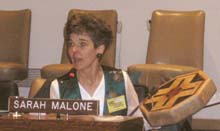 Sarah Malone is a storyteller from New Mexico who has compiled a CD of peace tales, poetry, and music entitled “Holding Up the Sky: Peace Tales for Kids.” Lessons in forgiveness, honesty, friendship and peacemaking are provided through the magic of story. Throughout the day, during intervals in the program agenda, she told stories from her collection. The CD can be ordered online from her website, listed on the following page of Info Fair participants.
Sarah Malone is a storyteller from New Mexico who has compiled a CD of peace tales, poetry, and music entitled “Holding Up the Sky: Peace Tales for Kids.” Lessons in forgiveness, honesty, friendship and peacemaking are provided through the magic of story. Throughout the day, during intervals in the program agenda, she told stories from her collection. The CD can be ordered online from her website, listed on the following page of Info Fair participants.
United Nations International School (UNIS) Junior 3 Chorus.
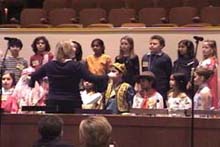
UNIS Choir
The United Nations International School provides an international education that emphasizes academic excellence within a caring community for kindergarten through twelfth-grade students from families of the United Nations and the international and greater New York communities.
The Junior 3 Chorus, made up of third-grade students, is under the direction of Brenda Bush and meets every Thursday morning before school. This was their first public performance outside of their school.
The students performed dressed in their national costumes. Their program began with “The United Nations Chant” arranged by Joan Litman and featured selections that complemented the international focus of the Conference.
CTAUN’s 2003 Best Practices Award
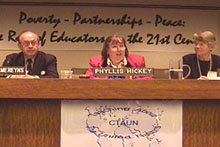
Awards for the best educational practices developed from the 2003 CTAUN Conference were presented by Phyllis Hickey, Second Vice Chair of CTAUN and principal of St. Mary School in Putnam, CT, and Raymond Sommereyns, Director, UN Department of Public Information’s Outreach Division.
The theme of the 2003 Conference was “Literacy Now: Building an Educated World.” The awards were given to two educators who had developed and implemented programs in keeping with the theme over the past year:
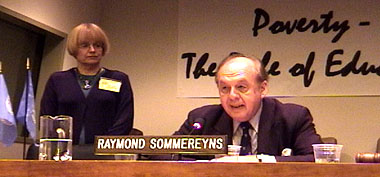
Libby Curran
Kearsage Area Children of Hope, Concord, NH — a multi-cultural reading buddy program.
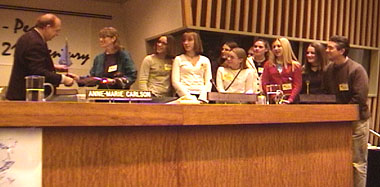
Info Fair
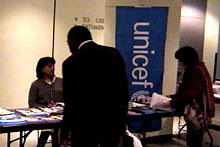
CTAUN’s Info Fair was held from 12:15 to 2 p.m. in a public exhibit area. Informational resources about programs designed to address problems of poverty were made available for educators. Books, posters and leaflets that explain projects, along with CDs and other media of use to educators were made available to Conference attendees.
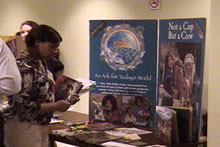
Info Fair Exhibitors
ATD Fourth World Movement – Diana Skelton (www.atd-fourthworld.org)
Dedicated to overcoming extreme poverty. Sponsors Tapori Children’s Network.
Franciscans International – Sister Florence Deacon (www.franciscansinternational.org)
Non-governmental organization (NGO) serving the global community by bringing spiritual, ethical, and Franciscan values to United Nations’ forums and agendas.
Fulbright Association Greater New York – Martin Haber (www.fulbright.org)
Information on programs of the Fulbright Association.
Heifer International – Heather Blackburn (www.heifer.org)
Provides livestock to lift families from poverty. Helps each family become self reliant for their food, income and health.
NetAid – Abby Falik/Nicole Pombier (www.netaid.org)
Presents “NetAid World Class”, the educational role-play game for children aged 8-12 and new educational materials.
New Partnerships for African Development (NEPAD) – Yvette Stevens (www.nepad.org)
Designed to address the current challenges facing the African continent such as poverty, underdevelopment and marginalization.
Office of United Nations High Commissioner for Refugees (UNHCR) – Yusuf Hassan (www.unhcr.org)
Since 1951, leads and co-ordinates international action to protect refugees and resolve refugee problems worldwide. Safeguards the rights and well-being of refugees.
Peace Corps World Wise Schools/New York Office – Timothy Torre (www.peacecorps.gov/wws)
Links K-12 students with currently serving volunteers and provides classroom materials for cross-cultural understanding in partnership with National Geographic.
Peace Tales – Sarah Malone (storyteller) (www.peacetales.org)
Provides message of peace and non-violent conflict resolution. Forms for ordering CD “Holding Up the Sky: Peace Tales for Kids” (2003) with proceeds going to Women’s Commission and Peace Talks Radio.
Right To Play – Chloe Flutter (www.righttoplay.com)
Improves the lives of the most disadvantaged children and their communities through Sport for Development. Supported by wide network of Olympic and professional athletes who donate their time.
Shared Interest – Donna Katzin (www.sharedinterest.org)
Invests in community-based economic projects and builds partnerships for social change in South Africa.
SOS Kinderdorf International – Children’s Villages – Elisabeth Shuman (www.sos-childrensvillages.org)
Provides young people with long term relationships, support and training to achieve goal of self reliance.
Teachers Without Borders – Judy Breck (www.teacherswithoutborders.org)
Works to close the educational divide through professional teacher development and community education. Primarily, but not exclusively, in developing countries.
Trickle Up – Jennifer Sullivan (www.trickleup.org)
Helps the lowest income people globally by providing conditional seed capital and business training for launching a micro-enterprise.
United Nations Children’s Fund (UNICEF) – Judith Yemane (www.unicef.org)
Partnerships for a world fit for children. Current information on programs worldwide.
United Nations Development Fund for Women (UNIFEM) – Nanette Braun (www.unifem.org)
Works for financial and technical empowerment and gender equality. Provides fact sheet and book catalog.
United Nations Development Programme (UNDP), Civil Society Organization Division — Katarina Kuai (www.undp.org)
Supporting Millennium Development Goals. Uses its global network to help the UN system and its partners raise awareness and track progress.
United Nations Division for the Advancement of Women (DAW),Department of Economic and Social Affairs – Carolyn Hannan (www.un.org/womenwatch/daw/)
UN Agency advocating peace agreements as a means for promoting gender equality and ensuring participation of women.
United Nations Educational, Scientific and Cultural Organization (UNESCO)Susan Byng-Clarke (www.unesco.org)
Presents information on education programming relating to peace and prosperity.
United Nations Food and Agricultural Organization (FAO) – Linda Murray/Dominique Burgeon (www.fao.org)
Founded in 1945, works to raise levels of nutrition and improve agricultural productivity of worldwide rural population.
United Nations Human Settlements Programme (UN-HABITAT) –Angel Gomez (www.unhabitat.org)
Promotes socially and environmentally sustainable settlements and adequate shelter for all in urban millennium.
United Nations Office for Coordination of Humanitarian Affairs (OCHA) – Rania Barrimo (www.reliefweb.int/ocha_ol/)
Assists in emergency relief, assistance and intervention for refugees.
United Nations Programme on HIV/AIDS (UNAIDS) — Nina Wessel (www.unaids.org)
Joint program of multiple UN Agencies advocating global action on the epidemic.
World Bank – Eduardo Doryan (www.worldbank.org)
Largest source of financing assistance to developing countries.
World Food Program (WFP) – Maggie Carrington/ Noel Victorino (www.wfp.org)
Set up in 1963. United Nations frontline agency in the fight against global hunger.
